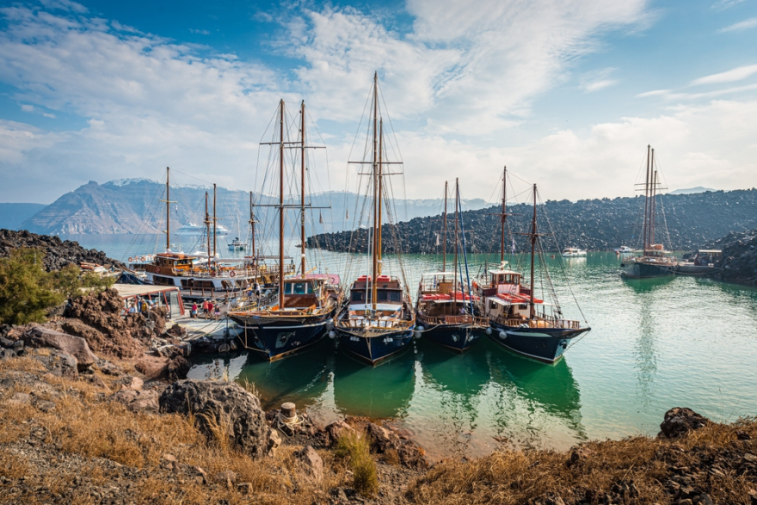I didn’t know much about Santorini before my then-toddler began to see Dr. Finkleman. While he was an excellent pediatrician and seemed to love his work, all he ever wanted to talk about was Santorini. The blue of the sea, the blue of the skies. Basically the blue. Through Dr. Finkleman, I learned a little about its history. Or perhaps I should say its mystery.
I learned it was perhaps the place where the lost city of Atlantis had fallen into the sea and that Plato mentioned it in his writing, noting it had disappeared 9,000 years ago. I also knew that experts believed that Plato had added an extra zero — perhaps the first recorded typo. Nine hundred years ago, instead of 9,000, would have put the disappearance of Atlantis at exactly the time when an eruption created its massive crater and awe-inspiring cliffs.

Volcanoes are not something I am normally drawn to as I am to, say, a Caribbean beach or a Parisian café. And swimming in the crater of one wasn’t exactly on my bucket list. But I am drawn to adventure and to stories. As we were looking over the various excursions offered aboard Windstar’s “Treasures of the Greek Isles” cruise, “Sailing the Caldera” appealed to me. The description — plunging into the green sulfur waters and a Greek lunch served on board — was alluring. The Atlantis mystery made me think that other stories like it would bubble up from the bottom of the caldera’s sea floor.
So on that June morning with a small clutch of like-minded passengers, we boarded our catamaran named the Odyssey (what else!). As we unmoored and began our gentle sail, our lovely guide, a young Greek woman named Vaso, explained to us what a caldera is. Basically it’s the crater of an extinct (or perhaps just dormant) volcano that is filled with water — in other words, an inactive volcano (one hopes). In Italy, part of the Bay of Naples is a caldera. We’d traveled there recently and learned about it, a miles-long fissure called Campi Flegrei that, were it to erupt, would ooze enough magma to fill 80 million Olympic-size swimming pools, according to one scientific report. The Campi Flegrei caldera has been in the news lately because of seismic activity — enough to keep residents in nearby towns on edge and with suitcases packed, and to have tourists cancel their Airbnbs.

Back to Santorini! The caldera below the cliffs of Santorini were formed 3,600 years ago in 1600 B.C. when the volcano at the center of what was once a huge island erupted, essentially wiping out Minoan civilization. The Minoans had sailed to Santorini from Crete around 3000 B.C. and they vanished after the eruption. But, as Vaso told her rapt audience of 12, including two teenagers, it remains an archaeological mystery that no human remains were ever found at what is known as the ancient site of Akrotiri. Vaso’s story had me remembering Dr. Finkleman’s tales about Atlantis. Did the Akrotiri people leave long before or did they have some warning and were able to flee? It is possible that no one will ever know and in some sense the mystery only adds to its magnificent allure.
We sailed the perimeter, with the massive cliffs of the caldera rising and encircling us, past Nea Kaimeni (New Burnt Island), one of the still smoldering volcanic cones of the caldera —in other words, inactive but not extinct, which is an important distinction. Here we stopped for a swim in the thermal springs around the nearby Palea Kaimeni (Old Burnt Island). We dropped anchor and those who wanted to do so jumped into the warm waters and floated around. That was what I’d signed up for and in I went.
The water strangely went from being very warm to cold, and other travelers and I joked about this. The underwater thermal springs bubble up, creating these warm patches, the equivalent of a Swedish shower that goes from hot to cold and back again. The thermal springs are just a reminder that there is still activity down there.
I don’t know how long we swam. Even as I drifted, time drifted away. I lay, paddling on my back, looking up at the pure blue sky Dr. Finkleman told me about so long ago.
Back on board we were offered glasses of chilled Greek wine. There was white and rosé, a nice selection. Soon we were moving slowly along again. I was struck by the smoothness of our little sail, the sweetness of the day, and a gentleness I’ve rarely felt as if I were being cradled by the caldera.
About 20 minutes later we pulled into a cove where there was a house and a few makeshift structures along with two little boats. They were both bright yellow. One appeared to be a covered dinghy, perhaps used for ferrying back and forth from the mainland. The other was an elegantly appointed gondola with red trim and a white canopy, lovingly designed. “This is the home of Sostis,” Vaso told us. And then she told us Sostis’ sad story.
Years ago, Sostis met an Italian woman who was visiting Santorini. They fell in love and decided to marry, but after a time the woman returned to Italy. Bereft, Sostis moved to this cove where he remained all these years, awaiting her return. The yellow gondola with the red trim was the ship he built for her return. Sostis lived more or less as a hermit for many years until recently. When he turned 75 and became ill, he relocated to the mainland, which apparently his family had been begging him to do for years. No one knows if he will ever return or what will become of his yellow boats.

Here we took another swim — though this time the waters were cooler with no warm water bubbling up. When we got back on board, lunch was served. We’d already been enjoying that Greek wine and it kept flowing as we dined on a spread of yogurt, tomatoes, a delicious Greek salad and chicken kebabs that were prepared on board. We each took our plates and perched ourselves either on deck or around the dining table in the shade. We went to the bow and joined a family of four who made room for us. The kebabs were juicy, the salad fresh, the wine cold and delicious.
Vaso had one more surprise for us before we docked at midday. We passed another inlet where there was a tiny church. “This,” she explained, “is the Church of the Seven Holy Young Men.” This church pays tribute to seven young Christian men who lived in Ephesus when the Romans conquered the area and required everyone to abandon Christianity and adopt the Roman gods as their religion. The seven young men refused and sought refuge in a cave where the Romans found them and sealed the cave, leaving the men to starve. Legend says that the men didn’t starve. Instead they slept for 200 years and only woke when Christianity was restored in the 19th century.
Then we made our way slowly back to the dock. In truth I did not want this journey to end. If we had to sail all day — or as in the Odyssey, for 10 years — I’m not sure I would have objected. I could see how this place of mystery and beauty could evoke stories of unrequited love, heroes and martyrs. And I could envision Dr. Finkleman, who eventually retired to this place, reveling each morning in all this blue.
Editor’s Note: Mary Morris, an award-winning novelist and memorist and her husband Larry O’Connor, a writer and book editor, traveled aboard Windstar Cruises’ Wind Spirit to the Greek Isles. While traveling, they were inspired to write a series of pieces about the experience – both onboard and ashore; if you enjoyed this post, check out their other pieces: What It’s Like: Sailing the Greek Isles on Wind Spirit; Discovering Greece’s Peloponnese via Nafplio and Monemvasia; and In Greece, Putting Food First. And we have even more stories on a cruise around Greece.


















































